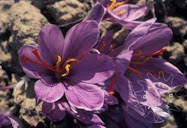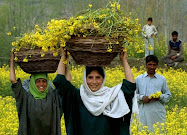 Hari-Parbat or only Parbat as it was fondly called has been since time immemorial a very fond attraction for the KPs especially of Srinagar. An old legend says that the place was a large lake inhabited by a ferocious demon Jalobhava. In order to save the valley from the demon Sati Mata the royal consort of Mahadeva took the form of a bird (Haer in Kashmiri) with a small pebble in its beak. She dropped it on the head of the demon and the miracle that ensued was that the stone enlarged rapidly and took the shape of present Hari-Parbat and the demon was crushed under it.
Hari-Parbat or only Parbat as it was fondly called has been since time immemorial a very fond attraction for the KPs especially of Srinagar. An old legend says that the place was a large lake inhabited by a ferocious demon Jalobhava. In order to save the valley from the demon Sati Mata the royal consort of Mahadeva took the form of a bird (Haer in Kashmiri) with a small pebble in its beak. She dropped it on the head of the demon and the miracle that ensued was that the stone enlarged rapidly and took the shape of present Hari-Parbat and the demon was crushed under it.The hill thus formed in place of the lake became the abode of numerous Gods and goddesses and particularly the shrine of Chakhrishur on its western face where Mata Tripursundari Sharika is seated graciously represented by the self made Srichakra engraved on a vertical holy rock (Shila). Number of holy temples representing various deities is located on all sides of the hill. So as a devotion to all these deities the devotees circumambulated the hillock to get their desires fulfilled. The Parikrama starts from the Lord Ganesh’s Shrine, which is located on the south-western corner. Inside the temple the deity is represented by a huge Shila. The next place of obeisance on the Parikrama route is the Saptrishi-Sthapna (Satresh) which is marked by an open space on the slope of the hillock near a big boulder in the vicinity of a Chinar tree. Here, the devotees ascertain their luck (locally known as Phal) by random picking up of some rice grains scattered on the boulder.
There are two Parikrama routes, one along the foot-hill of the hillock and the other along the fortified stone wall. The devotees have the option of taking either of the two. Further on, the next holy spot on the Parikrama is the shrine of Goddess Kali, which is marked by a small temple adjacent to a Chinar tree with a large flat open space in front known as Sidh-Peeth-- a place of lively divine presence. The shrine is said to be invested with very strong divine vibrations.
An old fort on its top built by Mughal Emperor Akbar exists there with ruins of a tall strong stone wall around the hill called Kallai in local dialect with ruins of two magnificent gates, Sangeen Darwaza and Kathi Darwaza. The wall enclosed an old populous city with the King’s palace along with the royal armory on its top. The view of Dal Lake and a part of the valley from the fort is most fascinating. Just near the southern side of the outer wall there is Gurdwara Chati-Padshahi which commemorates the visit of the Sikh Guru Shri Hargobind Singh Sahib.
Pokhribal, the shrine of the mother Raghnya is another holy spot on the Parikarma route. The holy spring inside the temple complex is the attraction of thousands of devotees.With the displacement of Pandits outside valley Hari-Parbat and lots of other important Hindu shrines in Kashmir seem in a state of neglect as most of them are guarded by security forces that’re unaware about the importance and sanctity of these places. It’s unfortunate that Kashmir, once a proud face of the Hindu India is changed altogether with its essential Hindu flavour missing now that was once its essential ingredient and none of the concerned neither the administration nor the people of this great country raise even a single voice against this great human tragedy.



.jpg)



